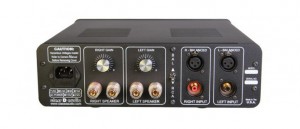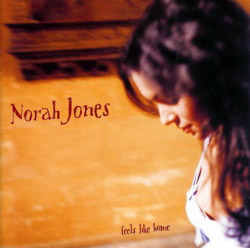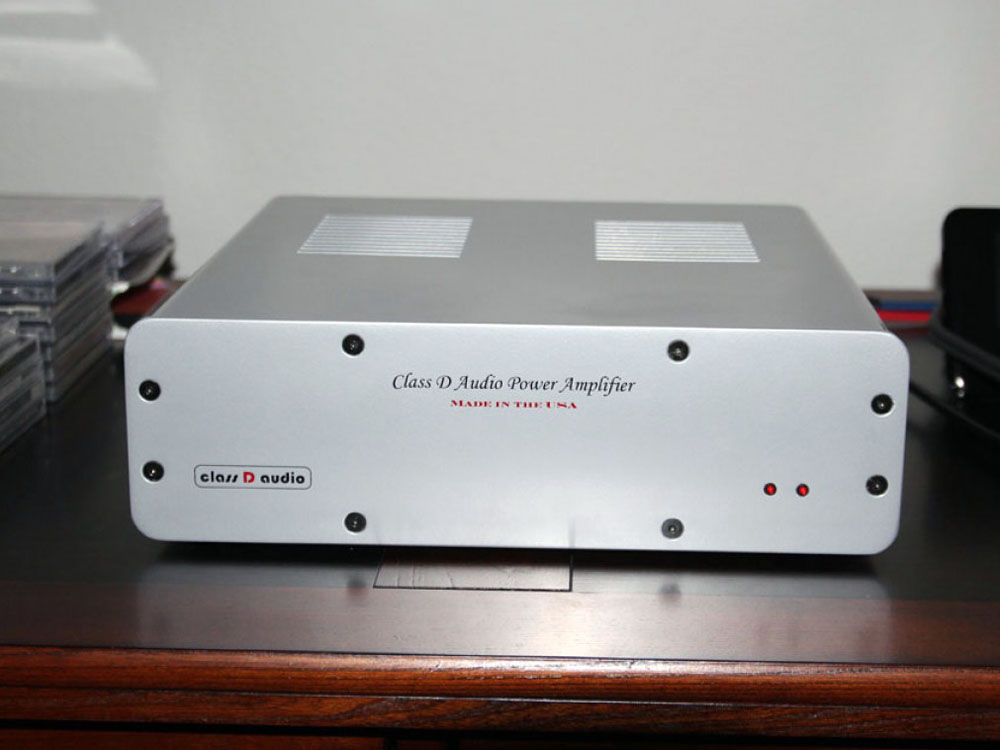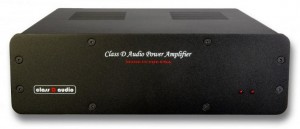Specifications:
- Two Channel Amplifier with adjustable gain
- 220W RMS Per Channel into 8 ohms
- 440W RMS Per Channel into 4 ohms
- Size: 12″ X 12″ X 3.5″
- Shipping Weight: 20 Pounds
- MSRP: $665.00
Class D Audio out of Southern California is owned and operated by Tom Ross. All of his operations including production are done right in Anaheim, California, which means his product line, top to bottom, are made in the U.S.A. Class D Audio has been reviewed in the August 2010, though this is the first time one of Tom’s factory assembled amplifiers has been publicized. The SDS-440C amplifier is the latest generation amplifier from Class D audio, and embodies Tom’s latest thoughts on amplifier design. I have used and owned several Class D amplifiers, and happen to have a competitive amplifier in house to compare to the SDS-440C. Tom was more than willing to send out an amplifier for me to test, so that our readers have the opportunity to be further exposed to his products.
When I opened the box, I was impressed by the medium size form factor of the amplifier sitting on my table. The first version SDS-440C amplifier that Tom sent me was not the standard 17″ width that I am used to with audio products. The amp is actually a smaller 12″ x 12″ x 3.5″, which has an attractive appearance in my equipment rack. The powder coated, sheet metal enclosure has rounded sides, the front panel is free from distractions such as switches, knobs, and the entire package is made just a few miles from Tom’s shop in Southern California. The power switch is actually on the right side of the enclosure, which gives the amplifier a clean presentation, and only leaves a few LED on the front panel for operational status. The rear of the amplifier houses all the IEC power plug, recessed RCA and XLR inputs with selector switch, 5-way binding posts, and individual channel gain pots. Removing the top reveals a cleanly laid out and wired chassis with a very large toroidial transformer and separate boards for the power and the amplification. The amp has a solid feel, and is heavier than it looks thanks to the thick front and rear plates, as well as the large transformer. All the connectors are as stout as the chassis of the amplifier, and the amplifier is absent of any mechanical noise when powered up.
 This Class D Audio amplifier is unusual due to the manufacturers claim of being able to drive low impedance speaker loads. Typically, less expensive class D amplifiers usually do not do well with reactive loads or dips, as the output chips cannot dissipate heat as fast as a transistor. Many of these amps do not have the ability to put significantly more power out into a 4 ohm load than they do an 8 ohm load, because of this limitation. With a rated specification of 220wpc at 8 ohms and that power doubling into 4 ohms, it looks like Tom designed an amplifier that is not typical. Class D amplifiers are also are becoming increasingly popular because of their “Green” title due to relatively low power usage and up to 90% effciency. There are many variations on class D designs used by manufacturers, but they all work by switching power devices off and on at a very high speed to create the amplification of the need frequencies. This amplification stage is then coupled to a filter, unlike classic A or B amplification, to filter out the noise created by the high speed switching, leaving only the inputted signal amplified. Despite the “D” title, class D amplification is not digital but a switching version of typical analog technology. Class D technology can be massaged in a few different ways similar to analog amplification, depending on what aspects of the amplification you are looking for; high power, low distortion, etc. With the growth of class D amplification lately, there seems to be a version for almost any audio application.
This Class D Audio amplifier is unusual due to the manufacturers claim of being able to drive low impedance speaker loads. Typically, less expensive class D amplifiers usually do not do well with reactive loads or dips, as the output chips cannot dissipate heat as fast as a transistor. Many of these amps do not have the ability to put significantly more power out into a 4 ohm load than they do an 8 ohm load, because of this limitation. With a rated specification of 220wpc at 8 ohms and that power doubling into 4 ohms, it looks like Tom designed an amplifier that is not typical. Class D amplifiers are also are becoming increasingly popular because of their “Green” title due to relatively low power usage and up to 90% effciency. There are many variations on class D designs used by manufacturers, but they all work by switching power devices off and on at a very high speed to create the amplification of the need frequencies. This amplification stage is then coupled to a filter, unlike classic A or B amplification, to filter out the noise created by the high speed switching, leaving only the inputted signal amplified. Despite the “D” title, class D amplification is not digital but a switching version of typical analog technology. Class D technology can be massaged in a few different ways similar to analog amplification, depending on what aspects of the amplification you are looking for; high power, low distortion, etc. With the growth of class D amplification lately, there seems to be a version for almost any audio application.
I always give new audio equipment a few weeks of break-in before I really sit down to give it a listen. After a good month of use, I sat down with a few albums to give the Class D Audio SDS-440C a good listen. For the sake of testing, I decided to start the amplifier out on two very different speakers to test its abilities with difficult loads and high efficiency drivers. The first was a custom pair of Carver ALIII ribbon speakers; this pair was modified at the factory to enclose the back of the ribbon for close placement to the wall, as well as enlarge the woofer box to improve bass response. The speaker will test the ability of the amplifier to deliver current to a speaker with a complex crossover load. The second pair of speakers was a stock pair of KRK KROK studio monitors with an average sensitivity and easy to drive load of 92db.
 As the volume rose on Norah Jones’ Feels Like Home, that first thing I could hear is the low floor noise of the SDS-440C. From zero to low volume, the amplifier was very quiet in its entirety, and provided a very quiet background for music even at a low listening level. With a little more gain, the music flowed from the ribbons with power and dynamics. Norah’s voice has so much body to it, and the combination of the Carvers and the Class D Audio amplifier driven by tubes pulled me away from reality until the album brought itself to a close. Having had listened to Norah Jones for many years, I have heard her voice reproduced both well and poorly, and this time the needle was pegged on the excellent side of the meter. The experience was almost perfect, except I heard a faint clicking noise in the left channel periodically, and usually only when no music was present. I had heard the noise since I received the amplifier, but could not figure out what the cause was or how to get rid of it. Immediately I shot an email to Tom to inquire about the clicking noise. His speedy reply was not surprised, and he stated that they had just found a heating issue on the amplifier board, which caused the audible clicking, and were redoing the traces in order to improve the performance, and overall quality of their product. I received an updated version of the SDS-440C amplifier in the mail the next week. Tom’s knowledge of the circuit, and willingness to continually refine his amplifier is a trait I certainly appreciate.
As the volume rose on Norah Jones’ Feels Like Home, that first thing I could hear is the low floor noise of the SDS-440C. From zero to low volume, the amplifier was very quiet in its entirety, and provided a very quiet background for music even at a low listening level. With a little more gain, the music flowed from the ribbons with power and dynamics. Norah’s voice has so much body to it, and the combination of the Carvers and the Class D Audio amplifier driven by tubes pulled me away from reality until the album brought itself to a close. Having had listened to Norah Jones for many years, I have heard her voice reproduced both well and poorly, and this time the needle was pegged on the excellent side of the meter. The experience was almost perfect, except I heard a faint clicking noise in the left channel periodically, and usually only when no music was present. I had heard the noise since I received the amplifier, but could not figure out what the cause was or how to get rid of it. Immediately I shot an email to Tom to inquire about the clicking noise. His speedy reply was not surprised, and he stated that they had just found a heating issue on the amplifier board, which caused the audible clicking, and were redoing the traces in order to improve the performance, and overall quality of their product. I received an updated version of the SDS-440C amplifier in the mail the next week. Tom’s knowledge of the circuit, and willingness to continually refine his amplifier is a trait I certainly appreciate.
Once I received the updated version of the amplifier from Tom at Class D Audio, I assumed that the amplifier would be exactly the same minus the improved board traces. I popped the hood on the amp to make sure, and immediately noticed a few internal wiring changes, as well as some surface mount components replaced with solder-in versions of the same; I would assume to improve power and heat handling. None of these changes surprised me given our previous conversation, until I noticed that the transformer was about 20% bigger! Functionally, both the old and new amplifiers gave off the same amount of heat after being powered on for one hour, and both were just slightly warm to the touch. Even after being left on for 24 hours, the temperature of the amplifier did not change or warm up any further. With a “new” amplifier on the shelf, and another couple weeks on time on its circuits, I started my testing again. With the Carver ribbon speakers in place, and the same Norah Jones playing as the first time around, I turned up the volume once again. After listening through a few tracks, the sound was exactly the same! However, do not be disappointed as that means Tom’s redesign was a success. He was able to alter the circuit to produce exactly the same sonic signature and depth of music, while removing the clicking noise caused by heating problems; success!
Next I turned the amplifier toward the KRK KROK monitors. Historically, these speakers have sounded pretty good with a variety of amplifiers; tubes and solid state. Always willing to be the pioneer and experimenter, I do not say that equipment does not pair well until I have tried it. Changing my set-up to see the flexibility of the SDS-440C, I swapped in a Luminous Audio Axiom II passive preamp and gave the speakers some volume. As Adele’s 21 started filling my room with soul, I could hear the slightly forward vocals that I have grown to expect from the KRKs, combined with a powerful midbass.  The studio monitors have a very clean and balanced sound with was supported by the Class D Audio amplifier, but they do lack the ability to play loud in any room larger than a small offce just like any speakers intended for near field application. The power output of the amplifier required me to not turn up the volume too loud or I would easily over push the KRKs and make them sound congested and strained. However, if I kept the volume at a reasonable level, the Class D Audio/KRK pairing sounded very clear and detailed, with neutral musicality. Wanting to keep the party going, I put the W30 back in front of the Class D Audio SDS-440C, and adding a little tube warmth to the mix, I played through Adele one last time. The tube and solid state combination provided a very nice music experience, and keep the sonic signature about the same as the passive preamp, while only erring slightly towards a softer attack of the music.
The studio monitors have a very clean and balanced sound with was supported by the Class D Audio amplifier, but they do lack the ability to play loud in any room larger than a small offce just like any speakers intended for near field application. The power output of the amplifier required me to not turn up the volume too loud or I would easily over push the KRKs and make them sound congested and strained. However, if I kept the volume at a reasonable level, the Class D Audio/KRK pairing sounded very clear and detailed, with neutral musicality. Wanting to keep the party going, I put the W30 back in front of the Class D Audio SDS-440C, and adding a little tube warmth to the mix, I played through Adele one last time. The tube and solid state combination provided a very nice music experience, and keep the sonic signature about the same as the passive preamp, while only erring slightly towards a softer attack of the music.
With the SDS-440C excelling at both the speakers so far, I decided to throw a popular mid-fidelity speaker at it for comparison. With the amp carted over to my Father-in-law’s house and connected to his Polk LSi15s, we played through the 24/96 re-release of Rumors by Fleetwood Mac. Similar to the Carver ALIII speakers, the Polk’s have a 4ohm impedance, and historically have required a lot of power. Once again I hooked up the Luminous Audio Axiom II passive preamp as volume control as I hoped the Squeezebox Touch would provide enough gain. We cranked the volume and the band sounded good, very detailed, very full, with a pleasing, warm tone and full sound stage. Once again, another low impedance, heavy load speaker that the Class D Audio amplifier made sing. For a fun comparison, we swapped the usually amp back in that my Father-in-law runs which is also a class D amplifier of similar design, but a different manufacturer. With the same equipment in the chain and the same album playing, we could hear no difference between the two amplifiers. Both sounded very good with the speakers, but the Class D Audio SDS-440C was 66% of the price of his W4S ST-250 amplifier at an MSRP of $999. Congratulations Tom, a fine amp built at a more than reasonable price.
I could only find a few limitations surrounding the amplifier through my review process. first of all, the amp did not pair well with my corner horns speakers, but I did not expect it to as most amplifiers do not. Second, I love the fact that the SDS-440C has gain pots for each channel to provide minute tweaking, but I wish the pots were either stepped, or the knobs on them were notched. With the amplifier in my component rack and the knobs on the back of the amplifier, it was hard to set them precisely without seeing them, and with them having no tactile feedback. However, I do know that this is a minor complaint, and that Tom has some hard design decisions to make when he sells an amplifier for as reasonable a price as the SDS-440C. Last, with the new and larger transformer, if something is set on top of the amp, the lid touches the bolt holding the transformer in place and buzzes due to vibration; although one should never be stacking equipment on amplifiers in the first place. Once again, it is an observation that I relayed to Tom during the review process, and I quickly received the reply that they switched to 1/4” shorter bolts in order to avoid the issue. As my short list demonstrates, I don’t have too many complaints about the Class D Audio SDS-440C, and really none of them would effect or even bother 98% of audio listeners out there who would consider purchasing an amplifier such as this.
The bottom line with Class D Audio and the SDS-440C amplifier is it’s a steal of a deal. This amplifier is on the same level sonically and aurally as most class D audio amplifiers out there, but at a less expensive price. Last time I talked to Tom on the phone, he said that his goal was to offer an all American made amplifier, at a price that is tempting to try for the average consumer. I highly recommend Class D Audio for any speakers that need or like gobs of power, especially low impedance and historically hard to drive units. As with any amplifier, not all amplification pairs well with all speakers. However, Tom’s SDS-440C paired extremely well with everything but the most sensitive horn speakers. If you want a project to go with your Class D Audio listening experience, remember that Tom also sells all of him amplifiers in kit form, which is how he got his start. The progression of products from Class D Audio over the last few years is very impressive, and I have it on good authority to keep an eye out for some new products that go beyond class D amplification.
SDS-440C manufacturer’s reply:
We have made recent adjustments to bring more refinement to the amps. They actually sound more powerful than ever now. The amplifiers can easily be adjusted for super-high effciency speakers, but in my opinion, if we make this adjustment to all amps, it might make the sound more like other class D amps on the market, meaning the sound would be a little flat compared to the exciting, lively sound and dynamics our amplifiers are capable of. This is a little hard for me to explain, but is reference to all of the reviews we get from around the world regarding the excellent sonic qualities of our amplifiers compared to other, including class d, amplifiers available today. For this reason I will choose to make these adjustments to those that are using high-effciency or other sensitive speaker systems; and of course, free of charge.
Thanks, Tom
SDS-440C review components
- Carver ALIII Speakers
- KRK KROK Monitors Polk LSi15 Speakers
- Grant fidelity W30 Integrated Amp
- Luminous Audio Axiom II Preamp
- Squeezebox Touch
- PC Music Server with lossless files
By Jake Montzingo, affordableaudio.org


How about *dating* your reviews (Dec. of what year)?
Yours,
Laurence
I agree about including the year with that date.
And gray text on a black background, that’s just ridiculously hard to read.
You reviews are good but your site sucks.
Don’t beleive what is said about classdaudio
is pure crap!
and all good reviews are FAKE!
specially on the classdaudio website
and owner doesn’t honor warranty
don’t buy before listenning YOU HAVE BEEN WARNED!
Maybe it’s just my old eyes, but I find the black background very hard to read from. Have you considered a brighter background, or alternatively a brighter contrast with your text? It would certainly help me. I really like your publication. Incidentally, I have a SDS 470C with upgraded power supply. Your review is consistent with my experiences with this fine amp.